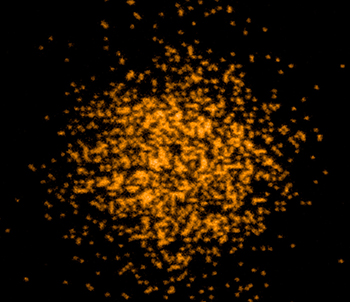
Sodium atoms diffuse out of an oven to form an atomic beam, which is then slowed and trapped using laser light. Credit: Jose-Luis Olivares / MIT
Fermions aren't just quarks and leptons—entire atoms can be fermions themselves if they contain an odd number of fermions, adding up to a half-integer spin. Because of the Pauli exclusion principle, studying strongly interacting systems of fermionic atoms has been a challenge.
A team at the Massachusetts Institute of Technology (MIT, USA) recently developed a “microscope” that can image up to 1,000 potassium-40 atoms trapped in an optical lattice (Phys. Rev. Lett., doi:10.1103/PhysRevLett.114.193001). The experiment simultaneously cools and images the atoms in the lattice.
MIT researchers in Martin Zwierlein's group, led by graduate student Lawrence Cheuk, first cooled approximately 1,000 40K atoms in the presence of sodium atoms and trapped them in a standard optical lattice. (The radioactive isotope 40K has 19 electrons in addition to its nucleons, so it's a composite fermion.) Next they magnetically moved the potassium atoms to the intersection of two infrared laser beams in a technique called Raman sideband cooling, which moves atoms to a lower vibrational state via Raman transitions, combined with optical pumping. A lens system just above the cloud of trapped atoms transmitted the resulting image to a detector.
The scientists estimated that they captured about 1,000 photons from each 40K atom for each second of exposure time (the image here resulted from a 2-s exposure). To check the quality of their images, the researchers examined the point-spread function of isolated atoms in the image and measured the full-width half-maximum at 640 nm, well below the laser wavelengths.
The MIT team also studied a series of images of the same quantum gas cloud to determine whether the 40K atoms were “hopping” from position to position within the lattice or falling out of lattice spots. They calculated an imaging fidelity rate of 94 percent or better between the images.
In addition to the imaging and atomic-manipulation possibilities resulting from their experiments, the researchers propose that their technique could also be used to trap and image ultracold, fermionic sodium-potassium molecules for quantum information processing.
